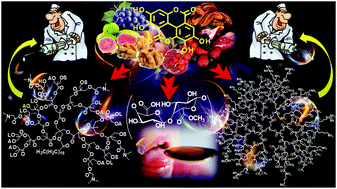Preparation of ellagic acid micro and nano formulations with amazingly increased water solubility by its entrapment in pectin or non-PAMAM dendrimers suitable for clinical applications†
Abstract
Ellagic acid (EA) is a bioactive natural polyphenol with antioxidant and several other beneficial properties, but unfortunately it cannot be exploited for in vivo therapeutic applications because of its poor water solubility and accordingly low bioavailability. Aiming to increase EA solubility, an EA solid microdispersion was realized by employing only water and low methoxylated pectin as a food compatible excipient by applying spray drying technology. It showed a 22% (w/w) Drug Loading (DL), a 30 times improved water solubility and remarkable radical scavenging activity. Subsequently, adopting non-PAMAM hydrophilic and amphiphilic dendrimers as nanocontainers, two EA nanodispersions were achieved (60–70 nm) with 46 and 53% (w/w) DL, water solubility 300 to 1000 times higher than that of free EA and good antioxidant capability. In both cases, toxic agents such as castor oil, Tween 80 or the extensively used but not so safe PEG400 were avoided and no previously used carriers, including β-cyclodextrins, were adopted. The prepared micro- and nanodispersions showed water solubility never obtained before and represent non-toxic EA reservoirs suitable for food and biomedical applications.



 Please wait while we load your content...
Please wait while we load your content...